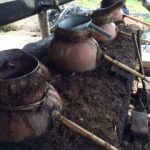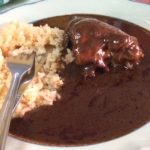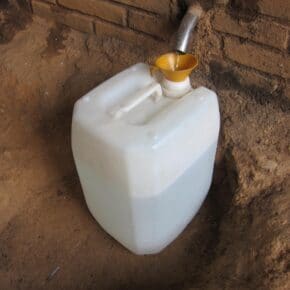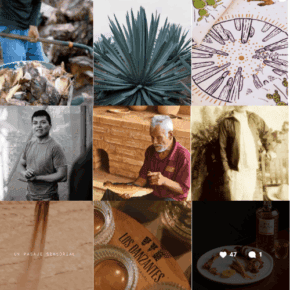Let’s get one thing clear, women have always been part of the mezcal industry. Historically, mezcal production has been a family affair and women were intimately wound into most aspects–from selling the mezcal at markets, to preparing the meals, to handling the finances, to actually making mezcal. What seems to be the new trend is women actually getting recognition for their part.
This has been an area of interest for me since, well, since mezcal has been of interest to me. As a woman, navigating the very macho world of spirits in general, and then specifically mezcal in Mexico, I can’t help but be drawn to the idea of the women working in mezcal and woman mezcal producers.
Today, only a handful of women run mezcal brands, but their numbers are growing. Graciela Angeles Carranza of Real Minero is perhaps the greatest example of a woman at the helm of a family business who has grown it exponentially and is now shipping product around the world. Then you have Reyna Sanchez, who learned how to make mezcal from family and has been producing fantastic mezcals while she works her way through the labyrinth of certification. I first met her in November of 2012 when she was making mezcal out of her cousin’s palenque in San Luis Amatlan. Through a grant, she built her own palenque and is known in Oaxaca for her madrecuishe and tepestate. You also have women like Sosima Olivera Aguilar who works with a collective in the Sierra Sur of Oaxaca and sells to bars, restaurants, and mezcalerias in Oaxaca. And of course you have others like Andrea Sánchez López of Aguas del Corazon mezcal, who has founded her own brand and works with mezcaleros in Oaxaca.
It makes for a great story: Women are beating the odds and finding economic opportunity in a male dominated industry! But I wonder just what the reality is. After all, Mexico really is a bastion of machismo in all its subtle and explicit varieties. So, this last trip I made a point of visiting the female mezcaleros I know and searching for any that I’d been missing. Were there more woman mezcal producers than I realized?
I started by telling Ulises Torrentera – mezcal expert extraordinaire and co-proprietor of Oaxaca’s In Situ – that I was interested in meeting women who were making mezcal and he made it a point of introducing me to various women at the Maestros event I went to in Oaxaca. I was fascinated by one woman in particular, Oliva Ramírez Laoreano, primarily because at 22 she is very young, and because she doesn’t fit the mold of the classic off-the-grid mezcalero that I frequently meet.
I’m used to meeting men with hardened hands and little experience with contemporary life while Olivia was texting away on her phone and just like a 22-year-old anywhere. At the Maestros event, Oliva was pouring tobala, espadin, and some of her cremas. The latter lends itself to lots of confusion because the literal English translation is “cream” but no dairy products are present in a mezcal crema, they are actually fruit-based mezcals, usually blends with jamaica or tamarind. We chatted briefly at the maestros event and then made plans for a visit with her in Sola de Vega, where she lives.
While at the Maestros event I also met anthropologist Ronda Brulotte, a professor at the University of New Mexico who is working on a huge research project about mezcal. We got together for breakfast a few days later in Oaxaca and talked through some of the issues and questions she has when discussing women and their role in the mezcal industry. While I tend to focus on the role of women as mezcaleras, Ronda digs deeper and has been asking whether the visibility of women in the mezcal world means that the deeper economics are changing. She wonders whether mezcal is actually bringing in more money to the families that make it and whether that’s changing the economics within the family income structure and whether women are getting more power or just sitting in traditional roles. After that breakfast it was quite clear that the story that we’d all love to believe, of a trend of women making mezcal, just isn’t that simple. We are seeing more female faces in the business when it comes to marketing and PR, but we don’t have any data to show there are more women making mezcal so it’s very possible that this whole idea is just wishful thinking.
That really weighed on my mind as I got ready to meet up with Oliva.
The drive to Sola de Vega in the Sierra Sur is beautiful – especially because it was the rainy season when everything is verdant. Coming from drought stricken California I felt like a broken record – it’s so green, oh my god look how green everything is, it’s just so, wow, green. The region is mountainous and reknowned for tobala.
Like all road trips, there is always a hitch, this one being we had no cell service and had to stop at a miscellenea to use a landline to figure out where were supposed to meet Oliva. I point this out to anyone wanting to do excursions outside of Oaxaca to more remote areas of Mexico – always have a communications back up plan. We were supposed to head to a supply store and, after some initial confusion as to which exact supply store, we found one another and headed out to the palenque she was using.
In addition to Oaxaca’s own Mezcalista, Ana JB, we met with Oliva, her brother, her uncle, and a cousin. Thankfully, the drive to the palenque was only about 25 minutes and the road not so badly rutted. Located in a beautiful, narrow valley, the palenque was simple and, at this time, still inactive. There was one wood fermentation barrel, four clay distillation pots, and a chipper to crush the cooked maguey. I want to get back to the chipper question later, for now I have a clear appreciation for their utility given how labor intensive mezcal making is. Some people claim that doing all the shredding by hand or with the tahona creates a clear difference in flavor so I really want to set up a tasting to evaluate this question. There was also plenty of maguey in the surrounding fields. The palenque is apparently certified and I am sure that factored into the reason Oliva wanted to use space.


July is when people are usually planting corn, so most mezcal production is on hiatus for these smaller guys. The palenque is owned by a great uncle who has been making mezcal his whole life. Oliva is learning from him and from her grandfather. Her brother, who is younger, probably about 18 or 19, has been helping as well, providing the much needed muscle for this back-breaking work. The two of them are, without doubt, the most beautiful palenqueros I have ever met. Most of this was explained by Oliva’s uncle, who did most of the talking about the project. It is his hope to create a cooperative of female mezcal makers, a noble concept, which he was clearly passionate about.
I have to admit, I was skeptical of all of this. Was Oliva actually making mezcal, or was she reselling her great uncle’s mezcal? Was she a front for a great story or is this the beginning of what could be a great economic driver for women in the cooperative? And if it is a legitimate project, how many other female mezcal makers are actually out there to make up a cooperative? Then there were other questions – Oliva had studied psychology in school so why would she return home to make mezcal? As I spoke with her uncle, she was quiet and not engaged, and when I asked her why she wanted to do this she really couldn’t answer.
I ended up buying a couple of liters of espadin from her great uncle. I paid 200 pesos to his wife before climbing back into the car to go to Oliva’s house near the center of town to taste her mezcal.

This was where everything changed and Oliva became completely engaged and animated- where she and her brother showed me the maguey starts they had going in the yard next to the house – a mix of tobala, tepestate, and sierra negra. We then sat down at the table, Oliva got glasses and began pouring – first cremas and then espadin and tobala. I am not a huge fan of the cremas, but I have to say, hers were pretty delicious and would make great cocktail mixers as well as playing key roles in the kitchen. I mentioned how they would be great reduced to syrups and poured over roasting meat or used on bread or tortillas with cheese. She immediately pulled out some queso and we began tasting the different combinations of the jamaica and tamarindo. And then there was the straight up mezcal which was quite tasty and showed skill and talent. Ironically, I would have bought the cremas, but she was down to very little until they started making mezcal again. We made do with the tobala, and I made her promise to get us the cremas as soon as possible.

We stopped for a quick meal before hitting the road home. We heard thunder in the distance and light rain danced on the tin roof as we chowed down on mole and tortillas and coffee. The sky was darkening as we climbed into the car and began the 2.5 hour journey home, chasing a storm the entire way back to Oaxaca.












Excellent article. So much passion and hard work. I also could mention Flor de Maria Velasquez from Mezcal Yuu Baal and Karla Moles from Enmascarado and Milagrito. They are both amazing and work really hard for their brands.
Thanks for the compliment Joel, I’ll definitely get into touch with Flor and Karla.